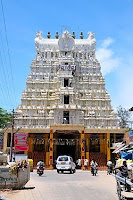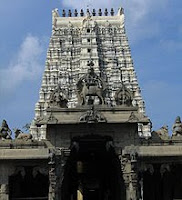Map:
Rameshwaram is a town in Ramanathapuram district in the Indian state of Tamil Nadu. It is located on Pamban Island separated from mainland India by the Pamban channel and is about 50 kilometres from Mannar Island, Srilanka. Pamban Island, also known as Rameswaram Island, is connected to mainland India by the Pamban Bridge. Together with Kashi, it is considered to be one of the holiest places in India to Hindus, and part of the Char Dham pilgrimages. Hence, it is a bustling pilgrim centre.
main gopuram of the temple
top view
east gopuram
west gopuram
It is situated in the Gulf of Mannar at the very tip of the Indian peninsula. According to legend, this is the place from where Lord Rama claimed to have built a Floating Stone Bridge Ram Setu (also known as Adam’s Bridge) from Rameshwaram that further continued to Dhanushkodi till Talaimannar in Sri Lanka to rescue his consort Sita from her abductor Ravana as mentioned in the great Hindu epic Ramayana .
Ram setu
The 2.3 km long Pamban rail bridge or Indira Gandhi Bridge is the longest sea bridge in India. It connects the island of Rameshwaram with the mainland of India. The central part can lift vertically to allow large ships to pass through. The rail line has been recently upgraded to broad gauge.
The Beach of Rameswaram is famous for its beautiful sea featured with no waves at all. The sea waves rise to a maximum height of 3 cm and the view looks like a very big river. Legend has it that Lord Ram of Ramayana prayed to the sea god to pave the way for Lanka. The sea god granted a boon saying that he will make the sea waves less to aid him in building a rock bridge.
Rameswaram is known for its long corridors and towers and 36 theerthams. 'Kashi of the south', Rameshwaram is an important Hindu pilgrimage, infact a pilgrimage without visiting Rameshwaram is not complete. It is said that in order to attain Moksha one must visit Rameshwaram. The presiding deity is the Linga of Sri Ranganatha, which happens to be one of the twelve Jyotirlingas of India.
The masterpiece of South Indian architecture boasts of the biggest temple corridor in India. Different rulers built the Ramanathaswamy Temple over a period of time starting from the twelfth century. The temple comprises twenty two wells where the taste of the water of each well is different from the other.
The grandest part of the temple is the 1219 m pillared corridor consisting of 3.6 m high granite pillars, richly carved and well proportioned. The perspective presented by these pillars run uninterruptedly to a length of nearly 230 m.
According to the Puranas, upon the advice of Rishis (sages), Rama along with Sita and Lakshmana, installed and worshipped the Sivalinga here to expiate the sin of Brahmahatya (killing of a Brahmin).( Ravana, the son of Vishrava and the great grandson of Brahma). Rama fixed an auspicious time for the installation and sent Hanuman to Kashi to bring lingam. As Hanuman could not return in time, Sita herself made a linga of sand. When Hanuman returned with a linga from Kashi, the rituals had been over. To comfort the disappointed Hanuman, Rama had Hanuman’s lingam (Kashilingam) also installed by the side of Ramalinga, and ordained that rituals be performed first to the Kashilingam.
Theertham (Water springs): There are 36 Theerthams in Rameswaram of which 22 are in the temple and these waters are said to possess medicinal properties. Bathing in these is considered to be of great significance. 100 metres away from the temple is Agni theertham which refers to the ocean, where Rama worshipped Lord Shiva, to absolve himself from the killing Ravana. Koti theertham is located within the temple itself.
Agniteertham
Koti teertham
Lakshmana Theertham is located in Rameshwaram. Here Lakshmana bathed.
Lakshamana teertham
Gandamadana Parvatham
This is situated in the north-west of the Rameshwaram island and is the most elevated point of the island. It is said that the Hanuman jumped from this point across the sea to reach Lanka. The imprint of Lord Rama's feet placed on a Chakra (wheel) is found in this shrine which is at the highest point on the island at 2 km from Rameswaram.
View from Gandamadana Parvatham
TV tower, the tallest tower in India
Places around Gandamadana Parvatham
Dhanushkodi
Dhanushkodi named after Rama’s bow, is at the eastern end of the island at a distance of
8 kms from Rameshwaram.
Ex-president of India, Dr. A.P.J. Abdul Kalam, hails from a fishing hamlet called Dhanushkodi situated on this island.
Some more pictures taken around Rameshwaram.
Hanuman Temple
Naga idols at Ram temple
Floating stones (Hanuman temple)












.jpg)


























.JPG)

